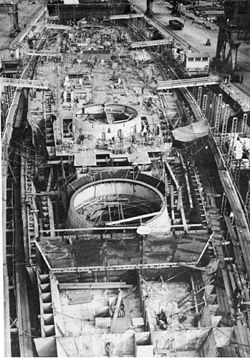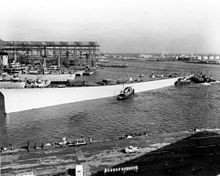
 USS Kentucky under construction. The barbettes which would have held the gun turrets are prominent. |
|
| Career (US) |
 |
| Ordered: | 9 September 1940 |
| Builder: | Norfolk Naval Shipyard |
| Laid down: | 12 June 1944 |
| Launched: | Canceled prior to launch |
| Struck: | 9 June 1958 |
| Fate: | Sold for scrapping 31 October 1958 |
| General characteristics | |
| Class & type: | Iowa-class battleship |
| Displacement: | 45,000 tons (planned) |
| Length: | 887 ft 3 in (270.43 m) (planned) |
| Beam: | 108 ft 2 in (32.97 m) (planned) |
| Speed: | 33 kn (38 mph; 61 km/h) (planned) |
| Complement: | 151 officers, 2,637 enlisted (planned) |
| Armament: |
(planned) 9 × 16 in (410 mm)/50 cal Mark 7 guns 10 × 5 in (130 mm)/38 cal Mark 12 guns 80 × 40 mm/56 cal anti-aircraft guns 49 × 20 mm/70 cal anti-aircraft guns |
| Armor: |
Belt: 12.1 in (310 mm) Bulkheads: 11.3 in (290 mm) Barbettes: 11.6 to 17.3 in (290 to 440 mm) Turrets: 19.7 in (500 mm) Decks: 7.5 in (190 mm) |
USS[a] Kentucky (BB-66) was an uncompleted battleship originally intended to be the sixth and final member of the Iowa class constructed for the United States Navy. At the time of her construction she was the second ship of the United States Navy to be named in honor of the U.S. state of Kentucky. Hull BB-66 was originally to be the second ship of the Montana class. However, the U.S. Navy's experiences in World War II led it to conclude that it required more fast battleships to escort the new Essex-class aircraft carriers that were being built. As a result, Kentucky was reordered as an Iowa-class battleship midway through the war. Like her sister ship Illinois, Kentucky was still under construction at the end of hostilities and was caught up in the post-war draw-down of the armed services. Her construction was suspended twice, during which times she served as a spare parts cache of sorts. In the 1950s, there were several proposals to complete the ship as a guided missile battleship. These were abandoned primarily due to cost concerns, and Kentucky ultimately was sold for scrap in 1958.
Background
Kentucky was one of the "fast battleship" designs planned in 1938 by the Preliminary Design Branch at the Bureau of Construction and Repair. She was to be the sixth and final ship of the Iowa class of battleships.[1] Like her Iowa-class sisters, Kentucky's construction began in response to the need for fast escorts for the Essex-class aircraft carriers. She was conceived in 1935, when the United States Navy initiated design studies for the creation of an extended South Dakota class that was not restricted by the Second London Naval Treaty. The latter four Iowa-class battleships (Missouri, Wisconsin, Illinois and Kentucky) were not cleared for construction until 12 July 1940,[2] and at the time Illinois and Kentucky were to be larger, slower battleships mounting twelve 16 in (410 mm) Mark 7 guns.[b][3]
Construction
Kentucky's main battery would have consisted of nine 16 in (410 mm)/50 cal Mark 7 guns, which could hurl 2,700 lb (1,200 kg) armor-piercing shells some 20 mi (32 km). Her secondary battery would have consisted of 20 5 in (130 mm)/38 cal guns arranged in 10 gun turrets, which could fire at targets up to 10 mi (16 km) away. With the advent of air power and the mandate to gain and maintain air superiority came a need to protect the growing fleet of Allied aircraft carriers. To this end, Kentucky was to be fitted with an array of Oerlikon 20 mm and Bofors 40 mm anti-aircraft guns to defend allied carriers from enemy airstrikes.[4]

The hull of the incomplete Kentucky is floated out of drydock to allow USS Missouri (BB-63) to drydock for repairs
Because the Iowa-class torpedo defense was virtually the same as the preceding South Dakota-class battleships it was proposed that Kentucky's hull be redesigned to provide a greater degree of torpedo protection for the battleship. Under the original construction schematics for the class each side of the ship was protected below the waterline by two tanks mounted outside the belt armor, and separated by a bulkhead. These tanks were initially planned to be empty, but in practice were filled with water or fuel oil. The armored belt tapered to a thickness of 4 inches (100 mm) below the waterline. Behind the armored belt there was a void, and then another bulkhead. The outer hull was intended to detonate a torpedo, with the outer two compartments absorbing the shock and with any splinters or debris being stopped by the armored belt and the empty compartment behind it. In 1939 the Navy discovered that this system was considerably less effective than earlier torpedo defense systems,[5][6] and as such the intended construction format for Kentucky would have addressed this problem by providing a 20% improvement to the torpedo defense of the battleship while simultaneously reducing flooding in the event of a torpedo strike. Despite providing additional torpedo defense for Kentucky the records are unclear on the matter of whether or not the idea was actually adopted.[7]
Kentucky's construction was plagued by suspensions. Her keel was laid down at the Norfolk Navy Yard, Portsmouth, Virginia, on 7 March 1942.[1] However, work on the ship was suspended in June that year, and Kentucky's bottom structure was launched to make room for LST construction on 10 June.[1][8][9] While her construction was suspended, the Bureau of Ships considered an aircraft carrier conversion proposal for Kentucky and Illinois in the aftermath of the Battles of Coral Sea and Midway. As proposed, the converted Kentucky would have had an 864-foot (263 m) long by 108-foot (33 m) wide flight deck, with armament identical to the carriers of the Essex class: four twin 5-inch gun mounts and four more 5-inch guns in single mounts, along with six 40 mm quadruple mounts. The idea was abandoned after the Bureau of Ships decided that the converted ships would carry fewer aircraft than the Essex class, that more Essex-class carriers could be built in the same amount of time, and that the conversion project would be significantly more expensive than new Essexes. Instead, Kentucky and Illinois were to be completed as battleships, but their construction was given very low priority.[10] Work on the ship resumed on 6 December 1944, when the keel structure was returned to the slipway. Work on the battleship proceeded at a slow pace, and her completion was projected for the third quarter of 1946. In December 1945 it was recommended that Kentucky be completed as an anti-aircraft battleship, and work on the ship was suspended in August 1946 while this was considered. Construction resumed again on 17 August 1948 without any decision having been made on her final design.[1] Work on Kentucky continued until 20 January 1950, when it was decided to halt work on the ship.[11] Following this, she was floated out of her drydock to clear a space for repairs to sister ship Missouri, which had run aground en route from Hampton Roads.[12][13]
Guided missile battleship
As early as 1946, missile conversion projects for Kentucky and the incomplete large cruiser USS Hawaii were discussed.[14] In the early 1950s, the advances in guided missile technology led to a proposal to create a large warship armed with both guns and missiles. To this end, the incomplete Kentucky was chosen for conversion from an all gun ship into a "guided missile battleship".[15] This proposal would have been relatively conservative, and would have involved the installation of a pair of twin arm launchers for the RIM-2 Terrier surface-to-air missile (SAM) on the aft deckhouse, with a pair of antennas for the associated AN/APG-55 pulse doppler interception radar installed forward of these, and the AN/SPS-2B air search radar on a short mast.[16] Since the battleship was already approximately 73% complete (construction had been halted at the main deck),[11] installation of the missile system and associated electronics would have involved only adding the necessary equipment without any need to rebuild the ship to accommodate the system.[c] The guided missile battleship project was authorized in 1954, and Kentucky was renumbered from BB-66 to BBG-1, with the conversion due to be complete in 1956. However, the project was soon cancelled, with the conversion ideas transferred to a smaller platform that led to the Boston-class guided missile cruiser.[16]
Another conversion project in early 1956 called for the installation of two Polaris ballistic missile launchers with a capacity for sixteen weapons.[1] She would also be equipped with four RIM-8 Talos SAM launchers with eighty missiles per launcher and twelve RIM-24 Tartar SAM launchers with 504 missiles. A July 1956 estimate projected completing the ship by July 1961, but the cost of the conversion ultimately forced the Navy to abandon the project.[17]
Fate

Kentucky being towed to the scrapyard; note her missing bow
Kentucky was never completed, instead serving as a supply cache of sorts while in the mothball fleet at the Philadelphia Naval Shipyard from about 1950 to 1958.[15] Hurricane Hazel hit the area on 15 October 1954; the storm caused Kentucky to break free from her moorings and run aground in the James River.[18] In 1956, Kentucky's bow was removed and used in the repair of Wisconsin, which had been damaged in a collision with Eaton on 6 May 1956.[15] Congressman William Huston Natcher attempted to block the sale of the ship by objecting to the bill in August 1957.[19]
Nevertheless, Kentucky was struck from the Naval Vessel Register on 9 June 1958 and her incomplete hulk was sold for scrapping to Boston Metals Company of Baltimore, Maryland, on 31 October.[11][20] Boston Metals Company paid $1,176,666 for the vessel, and towed her to their shipyard in Baltimore in February 1959.[17]
When the first two of the Sacramento-class fast combat support ships, Sacramento and Camden, were laid down in 1961 and 1964, the builders used Kentucky's four turbine sets to power the ships. This would later prove to be a beneficial decision: when the navy switched from 600 psi (4.1 MPa) boilers to 1,200 psi (8.3 MPa) boilers, sailors who had served aboard Sacramento and Camden were posted to operate the older boilers aboard New Jersey during her combat tour in the Vietnam War and aboard all four of the Iowas when they were recalled and modernized in the 1980s as part of the 600-ship Navy plan.[15] A pair of 150-pound (68 kg) mahogany doors were donated by the state of Kentucky while the ship was still under construction; they were used in an officer's club in New York City before eventually being returned to the Kentucky Historical Society in early January 1994.[21][22]



















